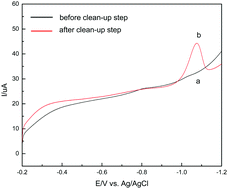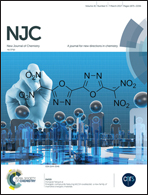Application of β-cyclodextrin–reduced graphene oxide nanosheets for enhanced electrochemical sensing of the nitenpyram residue in real samples†
Abstract
A sensitive, simple and cost-effective method for large-scale monitoring of nitenpyram (NIT) is important in food quality control. This study presents a new approach for the rapid detection of NIT using a glassy carbon electrode modified by β-cyclodextrin–reduced graphene oxide nanosheets, which exhibits a considerable improvement of the reduction peak current of NIT. After incubation at 0 °C for 8 min, the resulting electrochemical platform presented high sensitivity with a wide linear range from 5 × 10−7 M to 2.2 × 10−5 M as well as a low detection limit of 1.1 × 10−7 M by linear sweep voltammetry. In addition, water-extraction followed by liquid–liquid extraction pretreatment has been developed to improve the extraction rate and efficiently eliminate the interferent. This method has been applied for the determination of spiked NIT in three kinds of rice samples with the detection limit of 0.3 mg kg−1. The recovery was 74.56–107.15% and the results were validated through HPLC.



 Please wait while we load your content...
Please wait while we load your content...